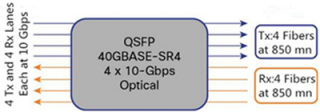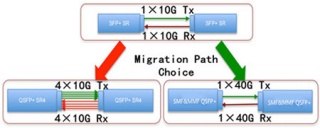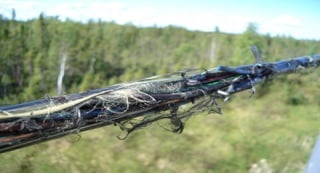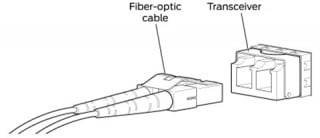40G Parallel & Bidirectional Optical Transceiver Introduction
petak , 29.04.2016.Speeds in data centers have maintained their growth in the past years, and will continue to do so in the predictable future. High-data-rate systems have become increasingly popular among some enterprises for high-performance computing networks, such as 40 Gigabit Ethernet (GbE) infrastructure, in which 40G fiber optic transceivers and cables are needed to ensure the high-performance and great-bandwidth of the 40GbE system. This article mainly introduces 40G fiber optic transceivers: the pluggable optical Enhanced Quad Small Form-Factor Pluggable (QSFP+), with focus on the bidirectional optical transceivers and parallel optical transceivers.
40G Optical Transceiver Types
The transceiver is an electronic device that receives an electrical signal, converts it into a light signal, and launches the signal into a fiber. It also receives the light signal, from another transceiver, and converts it into an electrical signal. With the 40G QSFP being the dominant transceiver form factor used for 40GbE applications, the IEEE standard 802.3ba released several 40-Gbps based solutions in 2010, including a 40GBASE-SR4 parallel optics solution for multi-mode fiber (MMF). Another solution is a bidirectional 40-Gbps transceiver that uses a two-fiber LC optical interface.
40G Parallel Optical Transceiver
40G parallel optical transceiver enables high-bandwidth 40G optical links over 12-fiber parallel fiber terminated with MPO/MTP connectors. Four fibers on one side are used to transmit, while another four on the other side are utilized to receive, leaving the middle four fibers unused. In total, eight of the twelve fiber are used. That is to say, when used for 40GBASE-SR4 and 40GBASE-CSR4, parallel optical transceiver has 10-Gbps electrical lanes that are mirrored in the optical outputs, causing the requirement of eight fibers with a MTP connector interface. Each fiber either transmits (Tx) or receives (Rx) 10-Gbps traffic at a single wavelength.
Just as mentioned above, 40GBASE-SR4 QSFP+ transceiver belongs to 40G parallel optical transceivers, which uses multi-mode MPO trunks to establish 40G links. This port type 40G QSFP+ module can support link lengths of 100 meters and 150 meters over laser-optimized OM3 and OM4 MMFs respectively. It can also be used to connect with four 10GBASE-SR optical interfaces using an 8-fiber MTP to 4 duplex LC cable. Fiberstore listed 40GBASE-SR4 optical transceivers are fully compatible with such famous brands, as Cisco, Intel, Juniper (QFX-QSFP-40G-SR4), and so on. All are quality-and compatiblity-assured, offering the high performance to customers.
40G Bidirectional Optical Transceiver
By contrast, 40G bidirectional optical transceiver consists of two 20-Gbps transmit and receive channels, enabling an aggregated 40-Gbps link over a two-strand MMF connection. That is, the bidirectional optical transceiver used for 40GBASE-SR-BD uses the same 10-Gbps electrical lanes, which are then combined in the optical outputs, thus requiring two fibers with an LC connector interface. Each fiber simultaneously transmits and receives 20-Gbps traffic at two different wavelengths.
Cabling Options for 40G Parallel & Bidirectional Optical Transceiver
Cabling Options for 40G Parallel Optical Transceiver
As previously mentioned, in 2010 IEEE 802.3ba approved the 40GBASE-SR4 physical-medium-dependent (PMD) multi-mode parallel optic solution, which uses eight fibers to transmit four duplex channels each at 10-Gbps. This is an economical path to 40GbE data rates, while using many of components of 10GbE solutions. The main advantage of the parallel optical transceiver over the bidirectional transceiver at 40GbE is the reach. For example, if you cable your data center with OM3 at 10GbE, you can support distances up to 300m. Then if you move to 40GbE, you can support the same 300m distance with the same OM3 fiber and a 40GBASE-CSR4 transceiver. However, if your cabling distances do not justify the extra distance capability, then the bidirectional solution would be used.
There exists a problem in this parallel optical cabling solution—MTP cable assemblies which built on 12-fiber position connectors, leaving four unused fibers in each link. There are several basic cabling options for parallel optics connectivity. One approach is to ignore the unused fibers and continue to deploy 12 fibers. Another approach is to use a conversion device to convert two 12-fiber links into three 8-fiber links.
Cabling Options for 40G Bidirectional Optical Transceiver
This two-fiber 40G bidirectional multi-mode solution tackles the challenge—polarity correction that occurs in a 12-fiber MTP connector., using two different transmission windows (850 and 900nm) that are transmitted bidirectionally over the same fiber. This approach allows the use of the same cabling infrastructure for 40GbE as was used for 1 and 10 Gigabit Ethernet. The pluggable bidirectional transceiver has the same QSFP+ format as the existing 40GBASE-SR4 transceivers. Therefore, the same switch line card with QSFP+ ports can support either parallel optics 40GBASE-SR4 or bidirectional optics 40GBASE-SR-BD solutions.
As such, while connecting a 40GbE bidirectional transceiver to another bidirectional transceiver, a Type A-to-B standard LC duplex patch cord can be considered, with one fiber in connector position A on one end and in connector position B on the other end. Such reverse fiber positioning allows a signal to be directed from the transmit position on one end of the network to the receive position on the other end of the network. However, this direct connectivity is recommended only within a given row of cabinets.
Conclusion
40G QSFP+ transceivers can meet the growing data center applications, such as big data and high-frequency trading (HFT) applications, and virtualized and clustered environments. With 40G bidirectional optical transceivers, no big changes to the existing cabling infrastructure are required, a cost-effective way for migration from 10-Gbps to 40-Gbps connectivity in data center networks. As a professional fiber optical product manufacturer and supplier, Fiberstore offers various 40G QSFP+ transceivers for your choice. Besides, many 40G cables (ie. QSFP-4SFP10G-CU5M) are also available for the smooth migration. For more information about 40GbE solutions (40G QSFP+ and 40G cables), you can visit Fiberstore.
Oznake: 40G parallel optical transceiver, 40GBASE-SR4, QFX-QSFP-40G-SR4, 40G bidirectional optical transceiver, 40G cables, QSFP-4SFP10G-CU5M
komentiraj (0) * ispiši * #
SMF&MMF 40G QSFP+ Transceiver Overview
srijeda , 27.04.2016.The demand for better network throughput and performance has never ceased. Instead, it has become more and more vigorous. The server consolidation, virtualization, as well as networking-service performance improvements, all these have pushed the necessity for dense 40GbE switch connections in data centers.
But when migrating to 40GbE from10GbE, some companies or organizations are challenged by two main factors in re-configuring the physical layer of the network: firstly, the possible reduced reach of the OM3/OM4 multi-mode optics from 10GBASE-SR (300/400 m) to 40GBASE-SR4 (100/150m), and secondly, the need to upgrade the existing fiber optic cabling plant so as to support the IEEE-defined 40GBASE-SR4 parallel optics. In order to avoid these questions, SMF&MMF 40G QSFP+ transceiver is brought to the market.
SMF&MMF 40G QSFP+ Transceiver Definition
It’s know that a fiber optic transceiver may either operate on single-mode fiber (SMF) or multi-mode fiber (MMF). However, this SMF&MMF 40G QSFP+ transceiver is able to communicate with both SMF and MMF, without the need for any software/hardware changes to the transceiver module or any additional hardware in the network. It has 4 channels (1270, 1290,1310, and 1330nm) of 10G multiplexed inside the module to transmit and receive an aggregate 40G signal over 2 strands of fiber with a duplex LC connector.
Based on IEEE defined 40GBASE-LR4 specifications, this supports distances up to 150m over OM3 or OM4 MMF and up to 500m over SMF. Certainly, different fiber optic equipment vendors may have different specifications.
SMF&MMF 40G QSFP+ Transceiver Advantages
SMF&MMF 40G QSFP+ transceiver is designed for seamless migrations from existing 10GbE to 40GbE networking without modification or expansion of the fiber network. It addresses several challenges faced by today’s data centers and the passages highlight the advantages of this transceiver.
No Redesign or Expansion of Fiber Network
Other short-reach 40G QSFP+ transceiver types, such as MMF 40GBASE-SR4 transceivers (100m over OM3 MMF), utilize four independent 10G transmitters and receivers for an aggregate 40G link. These 40GBASE-SR4 transceivers (eg. JG325B) use a MPO-12 connector and require 8-fiber parallel OM3 or OM4. As a result, customers installing MTP/MPO fiber systems may need to deploy new fiber while upgrading from 10G to 40G. However, SMF&MMF 40G QSFP+ transceiver uses duplex LC connector, which is consistent with the existing 10G connections. It works on existing OM3 and OM4 MMF infrastructure which is widely installed and used for 10GbE networks, thus free from redesign or expansion of the fiber network.
Increase in the Number of 40G Links
The existing MMF 40GbE solutions use of 8 fibers for a 40G link, and customers have to add additional fiber if they want to increase the number of 40G links. But if you deploy SMF&MMF 40G QSFP+ transceiver, the number of 40G links is 4our times of that existing MMF 40GbE solutions without any changes to their fiber infrastructure. During this link increase, the network scale and performance are also expanded.
A Cost-effective Solution for SMF Infrastructure
Limited in the distance reach that multi-mode transceivers can support, the migration from 10G to 40G, to 100G, or even 400G would become simpler with SMF. But single-mode transceivers typically cost up to 4 times more compared to multi-mode transceivers. Since SMF&MMF QSFP+ transceiver interoperates with QSFP-LR4 and QSFP-LR4L optics, it’s a cost effective solution for SM fiber infrastructure for distances up to 500m. And customers can deploy mixed connections without fiber concerns.
Simplification in Infrastructure Deployment
SMF&MMF QSFP+ transceiver boasts of the unique characteristic of working through both SMF and MMF without any requirement for additional fiber. Customers can consolidate their optics and use SMF&MMF QSFP+ transceiver in their network without concern about the fiber type, which makes the full use of existing cabling infrastructure, leading to the reduced equipment cost and simplification of deployment.
Conclusion
SMF&MMF QSFP+ transceiver allows data centers to migrate from 10GbE to 40GbE without redesigning or modifying the cabling infrastructure, providing companies or organizations a cost-effective solution to expand their fiber network. With SMF&MMF QSFP+ transceiver in hand, a smooth 40GbE migration at low cost is around the corner. Fiberstore SMF&MMF 40G QSFP+ transceivers are supplied to help you achieve smooth 40G migration. Besides, their interoperate QSFP-LR4 and QSFP-LR4L transceivers are also available, such as Cisco QSFP-40G-LR4 and WSP-Q40GLR4L. For more information about SMF&MMF QSFP+ transceivers, you can visit Fiberstore.
Oznake: SMF&MMF 40G QSFP+ transceiver, MMF 40GBASE-SR4, JG325B, 40GBASE-LR4, QSFP-LR4L, WSP-Q40GLR4L
komentiraj (0) * ispiši * #
XFP & SFP+ 10GbE Optical Modules Overview
srijeda , 20.04.2016.To accommodate an increasing number of bandwidth-hunger applications and traffic types, an ocean of safe-proof network products have been designed and released into market, including optical modules offered to satisfy the changing and fast-growing bandwidth demands in data centers. The optical modules are devices that connect the cabling to the network, providing interface between the equipment and the cabling, sending and receiving data.
There are various transceiver types available to match each Gigabit standard. For Gigabit technology, there are two defined transceiver types: Gigabit Interface Connector (GBIC), and the “mini-GBIC” or Small Form-factor Pluggable (SFP). For 10 Gigabit Ethernet (GbE) connectivity modules, there are three types: XENPAK (and related X2 and XPAK), XFPSFP+ and SFP+. This text mainly discusses the last two 10GbE optical modules types: XFP and SFP+.
XFP & SFP+ Main Features
Optical modules refer to optical transceivers which consist of a transmitter on one end of a fiber and a receiver on the other end. XFP and SFP+ can be plugged into routers, switches, transport gear, or pretty much any network device to transmit and receive signals. They are hot swappable while the device is operating, standardized to be interchangeable among vendors, capable of operating over many different physical medium and at different distances. Being hot-swappable input/output device, XFP and SFP+ have the following main features in common.
Allow flexibility of interface choice;
Support “pay-as-you-populate” model;
Designed with strong digital optical monitoring capability;
Optical interoperability with 10GBASE XENPAK, and 10GBASE X2 on the same link;
XFP Optical Module
Protocol-independent and hot-pluggable, XFP (10G SFP) is the first small form factor 10GbE optics, typically operating at near-infrared wavelengths of 850nm, 1310nm or 1550nm with LC connector. XFP modules can provide the required optical reach over different fiber optic types (e.g. multi-mode fiber, MMF or single-mode fiber, SMF), commonly available in several categories: SR, LR, ER and ZR.
10GBASE-SR XFP
10GBASE-SR XFP (eg. XFP-10G-MM-SR) is specified to work through MMF using 850nm lasers. This XFP type supports a link length of 26m on standard FDDI-grade MMF. And when using 2000 MHz/km MMF (OM3), 300m link lengths are possible. Fiberstore compatible Cisco XFP-10G-MM-SR is able to realize 300m distance reach over OM3 with the maximum data rate at 10.3125Gbps.
10GBASE-LR XFP
10GBASE-LR XFP is designed to operate via SMF using 1310nm lasers. The maximum link length that XFP 10GBASE-SR port type can support is 10km when it’s used in combination with high-quality optics.
SFP+ Optical Module
As the result of Multi-source Agreements (MSAs) that enable equipment manufacturers to produce 802.3ae-compliant pluggable transceivers, SFP+ modules use the same physical form factor as a Gigabit SFP. It’s the enhanced version of SFP. Nowadays, SFP+ has become a popular industry format supported by many network component vendors for 10GE systems. Similar to XFP, SFP+ also has different port types, like SR, LX4, LR, and so on.
10GBASE-SR SFP+
10GBase-SR is the original multi-mode optics specification, and is still by far the most commonly used. Since it uses a single, low cost solid state laser assembly, 10GBase-SR is the least expensive of the optical modules available for a 10GbE SFP+ platform. Just like 10GBASE-SR XFP, 10GBase-SR SFP+ is very sensitive to fiber type. When using standard MMF, the possible link length supported by 10GBASE-SR SFP+ is 26m, and when deploying OM3 or 10GbE-optimized fiber, the maximum link length is 300m.
10GBASE-LX4 SFP+
To break through the distance limitations of 10GBASE-SR optics, the 10GBASE-LX4 standard was developed later. LX4 uses 4 lasers, each operating at a different wavelength at a 2.5Gbps data rate, resulting in a range of 240-300m link length which depends on cable grade. However, due to the complex laser assembly, it is not possible to get LX4 optics in SFP+ versions. With the ready availability of OM3 fiber and newer standards that provide long reach over multi-mode with a single laser, LX4 has become obsolete nowadays.
10GBASE-LR SFP+
10GBASE-LR is a port type for SMF, supporting the maximum link length of 10km. During data transmission, a single laser operating at 1310nm is used, which allows LRM optics to be packaged in XFP and SFP+ form factors.
Conclusion
I detail the information about two 10GbE optical module types—XFP and SFP+ with the hope that you when you go on the task of one of the most confusing aspects—choosing and deploying 10Gig fiber switches. Fiberstore supplies various types of 10GbE optical modules, including SFP+ and XFP (XFP-10G-MM-SR mentioned above). Besides, other Gigabit standard modules are also available in Fiberstore, such as 1000BASE SFP transceivers (eg. Juniper EX-SFP-1GE-LX). If you want to buy such an optical module for your network connectivity, you can visit Fiberstore for your reference.
Oznake: 10GbE, Cisco XFP-10G-MM-SR, SFP, Gigabit standard module, EX-SFP-1GE-LX
komentiraj (0) * ispiši * #
Cat6 vs. Cat6a Cable
petak , 15.04.2016.Probably network designers who work in telecommunication industry are often met such questions in cabling installation: which cable type performs better and why is it. Some cabling installers even argue against each other and keep their own instances on the better cable type that they think is suitable for the projects. Cat6 and Cat6a are just in this case, since the selection of them leads to different opinions among users. Some prefer to the Cat6, while some choose the Cat6a. In this article, several aspects will be discussed to differ these two kinds, with the aim to help you choose the right cable type for your networking use more quickly.
Both Cat6 and Cat6a are unshielded twisted pair UTP or shielded twisted cables, suitable for Gigabit Ethernet (GbE) and other network physical layers. They are backward-compatible with Cat3, Cat5 (a cable type widely used in GbE applications in combination 1000BASE-T SFPs, eg. Cisco SFP-GE-T). Each deploy four twisted pairs in a common jacket to transmit data by using the same style RJ-45 jacks and plugs. When compare Cat6 with Cat6a, it seems that the only difference lie in the single lowercase letter—a standing for “augmented” that sets the two apart. However, differences are not limited to this one point.
Cat6 vs. Cat6a: Physical Properties
Firstly, Cat6 and Cat6a have their own identifiers printed on the cable jacket itself, so this provides a quick way to tell them apart. Secondly, Cat6a is thicker and bulkier than Cat6 just looking from outside. Thirdly, in terms of wiring structure, Cat6 is made of tightly twisted pairs of copper wires with extra insulation to reduce crosstalk, while Cat6a takes things even further by additionally twisting each pair around a flexible central plastic support.
Cat6 vs. Cat6a: Speed & Distance
It’s known that Cat6 and Cat6a are all designed for GbE and other standard network protocols, both being suitable for 10BASE-T, 100BASE-TX, 1000BASE-T, and 10GBASE-T. (Certainly, 1000BASE-T standard can also operate over Cat5 cables, such as GLC-T SFP.) At first sight, there is no big difference. But the real points come when you consider their transmission speed and distance. Cat6 cable is rated for 250MHz, and when used for 10GBASE-T applications, the maximum length maximum length ranges from 33m to 55m. In contrast, Cat6a doubles that capability by performing at up to 500MHz, allowing 10GBASE-T to be run over longer distances of up to 100m.
Cat6 vs. Cat6a: Crosstalk
Crosstalk happens when a signal from one channel or circuit interferes with another channel or circuit's signal. Cat6a has a lower-level crosstalk than Cat6a. Such reduction owes to alien crosstalk (AXT), which refers to the cables interfering with the signals of other cables in close proximity. This AXT pehnomenon is significant in Cat6 which is exposed to high frequencies, but quite low in Cat6a.
Cat6 vs. Cat6a: Durability
Due to the new central column support and ubiquitous shielding, Cat6a is much heavier and bulkier than the Cat6 just as what has been mentioned above. Cat6a takes more room, so that cable trays will not hold nearly as many Cat6a cables as they can for Cat6 cables.
Although Ethernet cables may seem sturdy on the outside, their inner parts are so fragile. To put in in another way, it is ill-advised to bend cables or cause winding of cables too much, as this can damage wiring and lead to performance degradation. Because of their bulkiness, Cat6a cable has a smaller bend radius than Cat6 cable.
Cat6 vs. Cat6a: Cost
Compared with Cat5e cables, Cat6 and Cat6a cables are more expensive, which mainly dues to the cabling length. But the cost differences between Cat6 and Cat6a cables are not so distinctive, or in other words, relatively small. For example, 5m Cat6 twisted pair patch cable sells at US$ 6.10 in Fiberstore, and the same length of Cat6a twisted pair patch cable in Fiberstore costs US$ 7.70.
Conclusion
In a word, Cat6a permits longer transmission distance for 10GbE applications and reduces crosstalk, but it’s bulkier and heavier in weight than Cat6. When you feel at a loss about whether to choose Cat6 or Cat6a cable, it’s necessary to outweigh the virtual points against weaknesses for your specific applications, then you can make a wise choice. Fiberstore offers various Ethernet cables for your copper networks, including Cat5, Cat6, Cat6a, and so on. For more information about Cat cables, you can directly connect me at Linkedin @Fern Xu (Fiberstore).
komentiraj (0) * ispiši * #
Why Choose 10 Gigabit Ethernet?
srijeda , 13.04.2016.Since Ethernet technology came into people's use in 1970s, Gigabit Ethernet (GbE) has long deminated the local area network (LAN) applications. But when to connect servers to storage area networks (SANs) and network attached storage (NAS) or for server-to-server connections, GbE seems to be not sufficient enough. In such a case, Ethernet has developed the later technology standard as newer, higher performing iteration—10GbE.
The Institute of Electrical and Electronics Engineers (IEEE) 802.3 working group has published several standards regarding 10GbE, including 802.3ae-2002 (fiber -SR, -LR, -ER), 802.3ak-2004 (CX4 copper twin-ax InfiniBand type cable), etc. Among these standard interfaces, 10GBASE-SR is the most-widely used type, like Cisco SFP-10G-SR and Cisco SFP-10G-SR-S. With 10Gigabit connectivity becoming widely available, 10GbE technology has emerged as the connection choice for many companies to grow their networks and support new applications and traffic types. Behind the 10GbE, there are three main advantages which explain why users choose it today.
Data Center Network Simplification
While Fibre Channel and InfiniBand are specialized technologies that can connect servers and storage, they can’t extend beyond the data center. However, a single 10GbE network and a single switch can support the LAN, server-to-server communications, and can connect to the wide-area network. Ethernet and IP network technology are familiar to network designers, so replacing multiple networks with a single 10GbE network avoids complex staff training. And by consolidating multiple gigabit ports into a single 10gigabit connection, 10GbE simplifies the network infrastructure while providing greater bandwidth.
Traffic Prioritization and Control
A major advantage of 10GbE is that separate networks for SANs, server-to-server communication and the LAN can be replaced with a single 10GbE network. While 10Gb links may have sufficient bandwidth to carry all three types of data, bursts of traffic can overwhelm a switch or endpoint.
SAN performance is extremely sensitive to delay. Slowing down access to storage has an impact on server and application performance. Server-to-server traffic also suffers from delays, while LAN traffic is less sensitive. There must be a mechanism to allocate priority to critical traffic while lower-priority data waits until the link is available.
Existing Ethernet protocols do not provide the controls needed. A receiving node can send an 802.3x PAUSE command to stop the flow of packets, but PAUSE stops all packets. 802.1p was developed in the 1990s to provide a method to classify packets into one of eight priority levels. However, it did not include a mechanism to pause individual levels. The IEEE is now developing 802.1Qbb Priority-based Flow Control (PFC) to provide a way to stop the flow of low-priority packets while permitting high-priority data to flow.
A bandwidth allocation mechanism is also required. 802.1Qaz Enhanced Transmission Selection (ETS) provides a way to group one or more 802.1p priorities into a priority group. All of the priority levels within a group should require the same level of service. Each priority group is then assigned a percentage allocation of the link. One special priority group is never limited and can override all other allocations and consume the entire bandwidth of the link. During periods when high-priority groups are not using their allocated bandwidth, lower-priority groups are allowed to use the available bandwidth.
Congestion control
802.1Qbb and 802.1Qaz by themselves don't solve the packet loss problem. They can pause low-priority traffic on a link, but they don't prevent congestion when a switch or an end node is being overwhelmed by high-priority packets from two or more links. There must be a way for receiving nodes to notify sending nodes to slow their rate of transmission.
IEEE 802.1Qau provides such a mechanism. When a receiving node detects that it is nearing the point where it will begin discarding incoming packets, it sends a message to all nodes currently sending to it. Sending nodes slow their transmission rate. Then, when congestion is cleared, the node sends a message informing senders to resume their full rate.
10GbE in Data Centers
For many institutions, especially those that utilize automated trading, uptime and response time is critical. Longer delays than a second can be exceedingly costly. With servers now being able to transmit bandwidth and network downtime, today’s data centers of some companies need extended bandwidth. 10GbE is an ideal technology to move large amounts of data quickly. The bandwidth it provides in conjunction with server consolidation is highly advantageous for Web caching, real-time application response, parallel processing and storage.
Conclusion
10GbE comes as the ideal connection choice for some companies, delivering greater bandwidth for sending data over Ethernet architectures with reduced cost and complexity. Fiberstore offers an ocean of 10GbE solutions, such as high-quality SFP+ modules (eg. Cisco SFP-10G-SR and SFP-10G-SR-S mentioned above). For more information about 10GbE equipment, you can visit Fiberstore or directly connect me at Linkedin @Fern Xu (Fiberstore).
Oznake: 10GbE, 10GBASE SR, Cisco SFP-10G-SR, Cisco SFP-10G-SR-S, SFP+ modules
komentiraj (0) * ispiši * #
Three Factors That May Destroy Fiber Optic Cables
srijeda , 06.04.2016.Fiber optic cable, which has become the essential component of nearly all modern computer and communications systems nowadays, has been deployed all over the world. Where there is a city, there are thousands of fiber optic cables connecting people to the networking systems. Without them, it’s hard get the information in real time. But there is a problem that once the fiber optic cable is damaged or cut, it may cause a big loss because of the network disruption. And we know that fiber optic cable is made up of pure glass, in some cases, it may be very fragile. This article gives you three factors that may destroy the cables.
Environment
The environment is the first thing you should take into consideration. Because in the extreme weather conditions, such as hurricanes, mud slides, flood and ice storms, ect., fiber optic cable would suffer great damage. If water enters, a splice enclosure can freeze, then this will crush the fiber strands and leave you with a costly network outage. Additionally, lightning is also a factor to destroy fiber cables. When lightning strikes the ground, it will search for the best conductor available, even if it’s underground. If that happens to be the armor or trace-wire of your fiber cable, then damage to the cable sheath and even the fiber itself is very likely.
Human’s Destruction
Here human refers to the people who steal the fiber. They cut the fiber thinking it has value and can be sold in pieces. The most classical event is that a 75 year-old woman in Georgia (country in Asia) was digging with her spade, looking for copper, which she wanted to sell for scrap, when she accidentally cut the fiber optic cable that provided internet to 90% of Armenia. It is ridiculous. It is fiber but not copper! In addition, people vandalize the fiber cable in other ways, e.g. for gun practice. This especially happens in the rough parts of town which makes the cable repair work become dangerous. Furthermore, land disputes which cause artificial malicious damage of fiber are also a fiber damage reason.
Animals Chew & Bite
We can try to reason with humans and publicize our buried fiber cable, but there is nothing we can do about the cable damage causing by animals. Squirrel, a furry little nut eater, seems to be deeply fond of fiber cable sheathing besides nuts. We even doubt that the cable manufacturers of using peanut oil in the sheathing. Since they have a life-long drive to gnaw, squirrel is often responsible for extensive damage to fiber optic cable. Even metal armored cable can get cut in two by this furry critter. In addition, undersea cables aren’t exempt from cuts. Because there is another kind of animal under ocean that is likely to bite cables. It is shark. Why shark would like to eat fiber cables? Effect by magnetic fields is one of the explanation at present. We have no idea how we can combat these wayward rodents. Now, only thing we can do is always looking for ways to improve.
Notes on the Use of Fiber Optic Cables
After mentioning three common factors that may do harm to fiber cables, there goes the basic information about the use of fiber cables and their related fiber optic transceivers.
Fiber cables are used as the transmission medium of fiber optic transceivers for high data-rate transmission in gigabit applications, with distance reaching from only several hundred meters on multi-mode fibers (MMFs) to 10km, 20km, 40km, 80km on single-mode fibers (SMFs). Take Gigabit Ethernet (GbE) applications for example, when 1000BASE-LX SFPs (eg. MGBLX1) work through SMFs, 10km link length is made possible; and 1000BASE-SX SFPs (eg. MA-SFP-1GB-SX) operates via OM2 (MMF), the possible distance reach is 550m. So when you choose fiber optic cables for fiber systems, it’s necessary to figure out what the distance reach is required first, and then you can deploy the right fiber cable type for different applications.
Conclusion
So after you obtain a good understanding of the three factors that may destroy the fiber optic cables, you must master how to protect the cables. Now, waterproof fiber cables, armored fiber cables and the other outdoor cables which are designed to protect fibers in a harsh application environment are widely used in this field. You can buy these fiber optic cable as well as the related fiber optic transceivers (MGBLX1, MA-SFP-1GB-SX, etc.) in Fiberstore which are really reliable. Any questions, please let me know.
Oznake: fiber optic cable, SMFs, MGBLX1, MMFs, MA-SFP-1GB-SX
komentiraj (0) * ispiši * #













